History provides no one solution for how the Army should respond to pandemics. Each pandemic presents different risks. During the 20th and 21st centuries, the U.S. Army has continued operations throughout different pandemics, and its response to each pandemic was calibrated. There has been no definitive approach—nor is one likely.
Army leaders must consider current missions against the specific medical risks at a particular time due to the pandemic agent, offset by available mitigation methods. Command decisions for balancing risks—from a pandemic against operational risks—differ in every instance because these decisions occur within a broader cultural context of acceptable health risks determined largely by available technology and scientific knowledge. Commanders can use preventive medicine techniques to protect the force, but with varying costs in reduced readiness and operational tempo. Various measures such as stopping recruiting, quarantining (or reducing access to) posts, pausing troop movements, suspending training, and dispersing troops all reduce disease spread—but also reduce readiness or combat power.
1918
Accepting Deaths by Disease to Win a World War
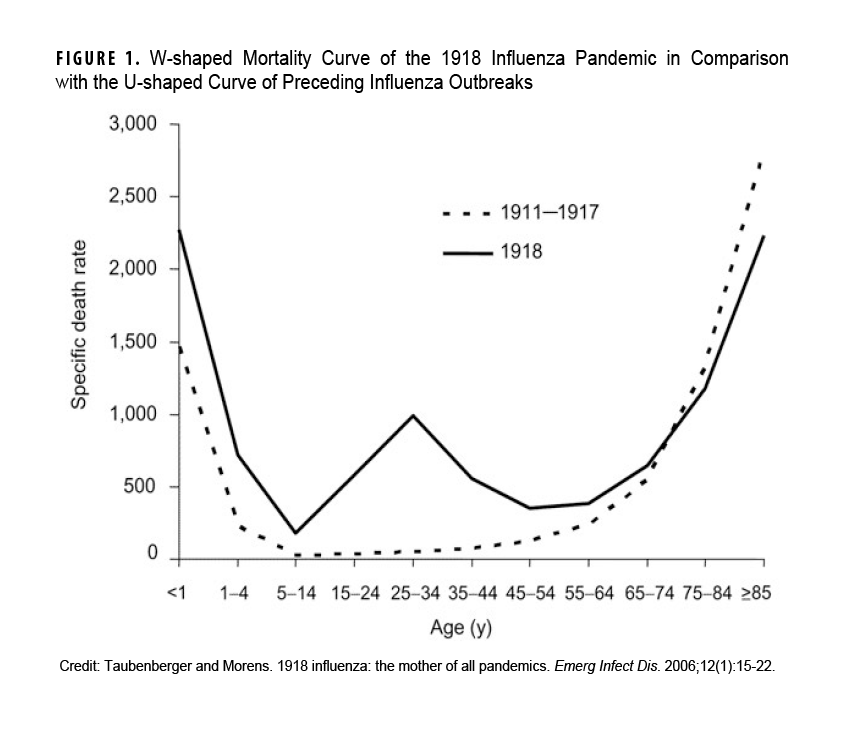 On October 7, 1918, President Woodrow Wilson On October 7, 1918, President Woodrow Wilson walked over to the War Department from the White House. In 1918 the world faced a fast-spreading influenza pandemic, which was deadliest among the military-age population (Figure 1). Wilson was upset, after a briefing by doctors about the medical situation that troops were facing on transport ships to France. The risk of disease due to the influenza pandemic was extreme, and Wilson wanted to talk with War Department leadership.
On October 7, 1918, President Woodrow Wilson On October 7, 1918, President Woodrow Wilson walked over to the War Department from the White House. In 1918 the world faced a fast-spreading influenza pandemic, which was deadliest among the military-age population (Figure 1). Wilson was upset, after a briefing by doctors about the medical situation that troops were facing on transport ships to France. The risk of disease due to the influenza pandemic was extreme, and Wilson wanted to talk with War Department leadership.
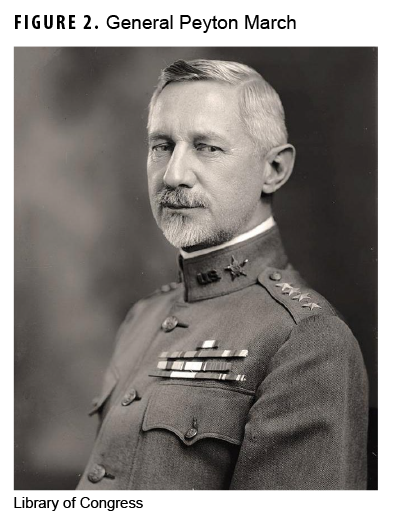 With the Secretary of War visiting forces in France, the Acting Secretary called in General Peyton March, the Chief of Staff of the Army (Figure 2). March knew that soldiers were going to die, whatever choice he made.1 He squared his shoulders and briefed the president on his decision: He was ordering packed troopships to continue sailing for France. It was not a risk but a certainty that soldiers on those ships would catch influenza, and some would die from it, some even before the voyage was over—but the mission was to beat the Germans, and these reinforcements would speed that outcome.
With the Secretary of War visiting forces in France, the Acting Secretary called in General Peyton March, the Chief of Staff of the Army (Figure 2). March knew that soldiers were going to die, whatever choice he made.1 He squared his shoulders and briefed the president on his decision: He was ordering packed troopships to continue sailing for France. It was not a risk but a certainty that soldiers on those ships would catch influenza, and some would die from it, some even before the voyage was over—but the mission was to beat the Germans, and these reinforcements would speed that outcome.
March laid it out for the Commander-in-Chief, including the medical advice he had decided to countermand. March was thorough in his briefing to Wilson; it was clear he understood the medical countermeasures, and their limitations. Puny mitigations were all he could offer. President Wilson accepted the Chief of Staff’s decision. Winning the war for everyone was more important than reducing the risk to individual doughboys.
In August and September 1918, while in the U.S. the lethal mutation of the virus was spreading, in Europe the Allies had engaged in massive military offensives. The major American efforts at St. Mihiel (September 12-16) and Meuse-Argonne (September 26–November 11) resulted in over 100,000 battle casualties. The American Expeditionary forces needed replacements as well as reinforcements, and reducing the flow of troops—pulling America’s punches—would undermine those offensives, reduce American influence during inter-Allied negotiations, and lower American prestige at the imminent peace negotiations.
The U.S. Army knew about avoiding communicable diseases; in a time before antibiotics, an ounce of prevention was worth a pound of cure. Army doctors had immense credibility with line officers when they recommended any of a range of disease countermeasures, especially spacing between soldiers to prevent airborne spread of disease.2 World War I was an existential threat, however, and the line accepted more crowding to train more men within limited facilities. Disease outbreaks during the winter of 1917-1918, especially measles, had sickened approximately 95,000 soldiers, but those outbreaks were nothing like what would happen in late 1918.
At the end of August 1918, upon receiving news of the lethal flu variant at an Army base, Surgeon General William Gorgas had taken immediate action. Gorgas sent warnings to Army hospitals and recommended stop-move orders to Chief of Staff March.3 March considered Gorgas’s advice, but ultimately rejected most of it. When the disease had been containable, March had canceled troop moves from camps with outbreaks, but once influenza began spreading rapidly, he apparently thought troop movements would make little difference.2 At the time scientists could not yet identify viruses, only bacteria, and were unable to determine just what was spreading or how. March understood that Army actions would further spread the pandemic, killing more soldiers and civilians, and he had accepted that outcome. Victor Vaughan, former president of the American Medical Association who served as a colonel during WWI, recalled being told by his command that “The purpose of mobilization is to convert civilians into trained soldiers as quickly as possible and not to make a demonstration in preventive medicine.”3
Influenza quickly swept across the U.S. throughout September 1918. The flu arrived in Kansas City on September 23, and within a week Fort Leavenworth placed restrictions on leave and passes, and delayed draftee arrivals. Fort Leavenworth did not have a large troop population, housing its troops in a range of forms: in pre-war barracks along with wartime constructions, in addition to the prison, while some troops attended civilian schools in Kansas City. By September 29, on post 18 influenza cases had been identified—and then 100 the next day. That surge in case numbers presumably drove the order on September 30 to refrain from entering crowded buildings such as theaters and restaurants, and to abstain from spitting, with instruction to use handkerchiefs when sneezing or coughing.
In late September and early October 1918, in the midst of the Meuse-Argonne campaign in France, which was generating cables emphasizing the need for more troops, the Army experienced its fastest influenza spread: about 80,000 influenza infections during the week of September 28 through October 4, compounded by another 89,000 the following week. Gorgas recommended halving the loading of troop ships for the 2-week voyage to Europe, after week-long quarantines at embarkation camps before boarding. General March overruled the Surgeon General’s recommendations, which led to his meeting with President Wilson on October 7. Following the meeting between Wilson and March, troop ships would be just as packed as before, but troops’ temperatures would be checked before embarkation, and they would be asked about symptoms. It is hard to credit that March or Wilson believed these measures would have meaningful impacts (Figure 3).
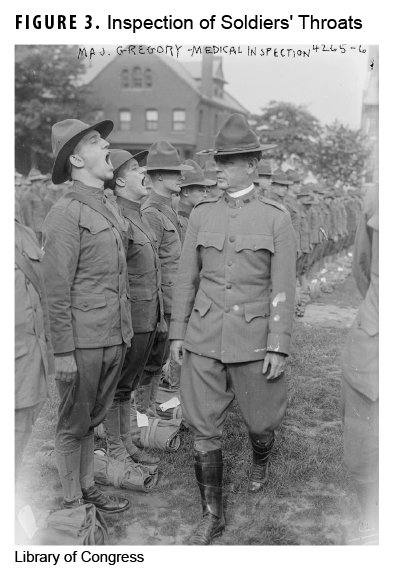
Not understanding exactly how the disease spread, in the U.S. there was an effort to certify buildings (e.g., restaurants, cinemas, or ice cream parlors) as sanitary and permissible. Differing city and state responses to the growing pandemic included closures of schools, theaters, and churches, as well as limiting group sizes. The Army adopted various techniques that today would be termed “social distancing,” for both off- and on-duty service members: reducing training, keeping troops on post, closing posts to visitors (although not fully quarantined), suspending church services, and other measures to avoid crowding.2,4 On October 8 tenant units of Fort Leavenworth were instructed to read aloud the September 30 orders, with commanders to report compliance. By October 26, more than a month into the local Kansas City epidemic, church services on post were suspended—and there were to be no gatherings of any kind, including troop training.
Meanwhile, in Europe the operational situation was rapidly shifting: Multiple Allied attacks had reinforced the others and forced Germany to request an armistice on October 5. Quickly, the Army’s response to the pandemic changed. Draft call-ups were both delayed and reduced—but not stopped—to reduce both crowding in training camps and patients in Army hospitals.3
By November 2, Fort Leavenworth was able to lift its restrictions, with mixed results. Contemporary data are scarce, but in 1917 Fort Leavenworth’s disciplinary barracks registered 41 cases of pneumonia or influenza, with four deaths, but in 1918 the disciplinary barracks reported 293 cases and 86 deaths, among only 2,026 prisoners.5,6
The U.S. Army ultimately suffered an estimated 50,000 fatalities from influenza in WWI, a number almost certainly increased due to General March’s decisions. As the pandemic escalated in late summer 1918, March could not have known how soon the fighting in Europe would be over; if battles had continued through the fall and into 1919, American battle casualties would likely have exceeded the added deaths due to influenza. The cessation of fighting within the first weeks of autumn 1918 was the determining factor of whether disease or battle deaths were to be greater that year.
In hindsight, March’s deliberate, even calculated, inaction in all likelihood caused more deaths among U.S. troops, along with the civilian population, but at the time March judged it the better choice. Once operational pressures at the front eased, he chose to increase disease-mitigation protocols. General March adhered to his commander’s intent by prioritizing measures for winning a world war, and not the battle against an influenza pandemic.7
1968
Calculating Risk Against Progress
In the 1930s new technologies had allowed viruses to be identified, including various strains of influenza virus. An influenza vaccine developed in the 1940s was compulsorily administered to service members during World War II. At the same time, the Army epidemiology board evaluated masks as a preventive measure, but found they had insignificant protective value.7 There was no pandemic during WWII; penicillin would have helped with combatting secondary infections, but the Army was watchful. Later, in the 1950s and early 1960s a number of new vaccines were developed, notably the polio and measles vaccines, in addition to the research and development of mumps and rubella vaccines.
In July 1968 another influenza pandemic started in China, reaching the wider world through Hong Kong, then a British colony. The U.S. Army promptly learned of the “Hong Kong flu” outbreak, and a team from the 406th Medical General Laboratory (the forward-deployed diagnostic laboratory for Pacific Command, based in Tokyo) went to Hong Kong. From the data collected during that visit, the Armed Forces Epidemiology Board considered possible actions.8
The new flu of 1968 was H3N2, somewhat similar to 1957’s mild pandemic of H2N2 influenza, and their N2 similarity could offer limited protection. Moreover, six U.S. vaccine manufacturers could attempt different approaches, increasing odds of achieving an effective vaccine quickly.9 The Board decided to recommend no immediate action, but instead to wait and rely upon an efficacious vaccine.
If expectations in 1968 were to prove erroneous—that the newest pandemic would affect not just the old and the young (i.e., a U-shaped curve) but include young adults (i.e., a W-shaped curve)—the military had a large hospital system for further risk mitigation. With epidemiologists recommending no immediate action, the Army, unsurprisingly, took none. Soldiers are generally a young and healthy population. Recruitment and draft call-ups continued unabated, with training, worldwide movements, and operations uninterrupted. Fighting in Vietnam increased.
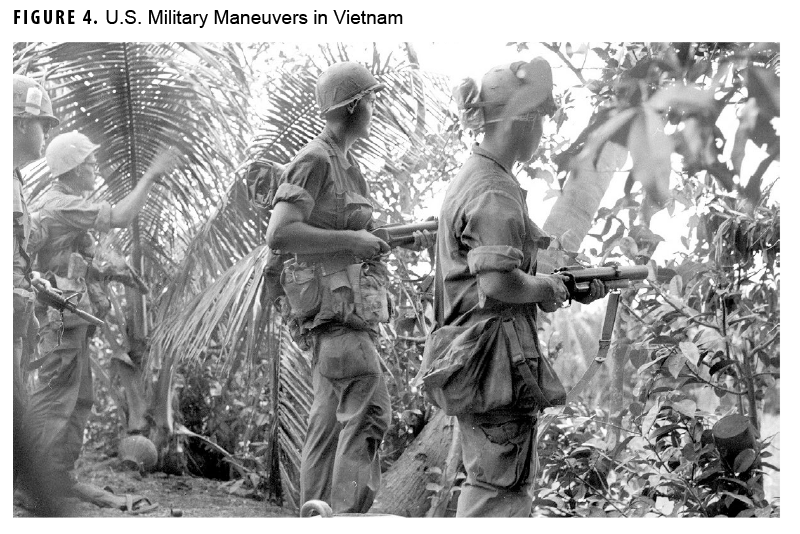 The following year, 1969, would be America’s bloodiest in Vietnam, but not from the pandemic (Figure 4). The pandemic was essentially ignored in Vietnam; rest-and-relaxation leave to Hong Kong was not stopped, although it was a known factor in the disease’s spatial spread. Troop rotation from Vietnam back to the U.S. likely helped spread the virus domestically.8,10 Routine troop moves to U.S. Army Europe (USAREUR) may have expedited H3N2’s arrival to Germany.11 Neither the 44th Medical Brigade (the medical headquarters in Vietnam) nor USAREUR even mentioned the pandemic in their annual reports.12
The following year, 1969, would be America’s bloodiest in Vietnam, but not from the pandemic (Figure 4). The pandemic was essentially ignored in Vietnam; rest-and-relaxation leave to Hong Kong was not stopped, although it was a known factor in the disease’s spatial spread. Troop rotation from Vietnam back to the U.S. likely helped spread the virus domestically.8,10 Routine troop moves to U.S. Army Europe (USAREUR) may have expedited H3N2’s arrival to Germany.11 Neither the 44th Medical Brigade (the medical headquarters in Vietnam) nor USAREUR even mentioned the pandemic in their annual reports.12
Bases in the U.S. took little notice of the pandemic, indeed even less than some civilian institutions. Some colleges closed, sending students home, while some hospitals limited visitors.11 The entire military district that covered central Louisiana to Fort Bliss, Texas, and as far north as central Oklahoma, had no confirmed H3N2 cases through December. Fort Sam Houston in San Antonio enacted no restrictions. Trainees visited San Antonio, and local residents came on post. Recreation and meetings were unaffected. There was no mention at all of influenza in the post newspaper, with little mention in the civilian press.19-25 Contrasted with the restrictions a half century earlier at Fort Leavenworth, the U.S. response to the 1968 H3N2 pandemic was extremely limited.
Confidence in vaccines was high in 1968, and mitigation measures were available, doubtless making risk-taking easier. The media campaign for the 1968-1969 influenza vaccine seemingly increased, and the vaccine was mandated for active duty troops. (Influenza vaccine strains developed before the H3N2 version also proved to provide some protection.14) By November 1968, a mere four months after the pandemic was identified, 1,000,000 H3N2 vaccine doses were available, and in early 1969 doses arrived in Vietnam. The history of medical support in Vietnam notes “only a few cases appeared in military units in Vietnam,” then simply asserts that the vaccine became available in January 1969.18
These calculated risks created negligible adverse consequences. The Army’s rate of influenza cases in the 1968-1969 season was only slightly higher than in previous years, and affected neither combat operations in Vietnam nor deterrence in Europe.15-17 The 1968 pandemic seems to have sickened 1-2% of troops at worst, who were off-duty for only a few days.13 In 1968, the acceptable answer was to do almost nothing.
2009
Advocating for Better Practice
An H1N1 swine influenza was first detected in the U.S. in 2009, and by June the outbreak had been declared a pandemic. The U.S. reported the most swine flu pandemic cases in the world, with cases recorded in every state.26 Few individuals in the military-age population had antibodies, while around one-third of persons over 60 years of age were found to have antibodies.
The H1N1 variant was neither more contagious nor more virulent than seasonal influenza. The U.S. Centers for Disease Control and Prevention guidance cautioned institutions, as well as officials and individuals, not to react strongly. The influenza virus and countermeasures were well understood, and officials were confident that a vaccine could be produced in time to reduce widespread public health effects.
The Department of Defense followed the guidance provided by the CDC. DOD’s response focused on hygiene—coughing into the elbow was stressed—and use of antivirals when appropriate, in addition to vaccination. The annual influenza vaccination program was advocated more aggressively, including vaccination for family members.
Amid operations in Iraq and Afghanistan, DOD response to a pandemic that was mild in nature could be limited. This proved reasonable. Even though the military population had little previous exposure, the virus was neither more contagious nor more virulent than seasonal influenza. The Military Health System had approximately 1,000 hospitalizations for influenza, averaging 3.63 days in hospital.27 The greatest cost incurred by the DOD for the 2009 H1N1 pandemic was for the more robust annual vaccination campaign.
2020
Protecting Service Members Against Unknown Effects
In the half century that followed 1968, public safety had become more prevalent within civilian society as well as the Army. 1968 was the first year new cars were required to have seatbelts—while wearing them was still optional—and the Occupational Safety and Health Act was passed three years later, in 1971. In 1968 the Army safety program addressed only aviation accidents; the Army Safety Center was created 10 years later, in 1978. If the phrase “protecting the force” was used in the mid-20th century, it was understood differently.
U.S. life expectancy increased from 70 in 1968 to 79 by 2020, with many older individuals survivors of cancer or on dialysis, neither of which was common in 1968. Medicine had also changed, emphasizing outpatient care, with a far smaller military hospital system as a result.
In 2020 the world situation was comparatively benign. Few troops were deployed, and even fewer were in combat. The Army had been an all-volunteer force for almost 50 years. The military could focus on protecting the force, including military families and the military’s civilian workforce (Figure 5). Accidents often damaged commanders’ careers. Army commanders recognized the individual soldier as the Army’s most important weapon, with families viewed as important keys to soldier retention. The importance of an effective civilian work- force was similarly emphasized.
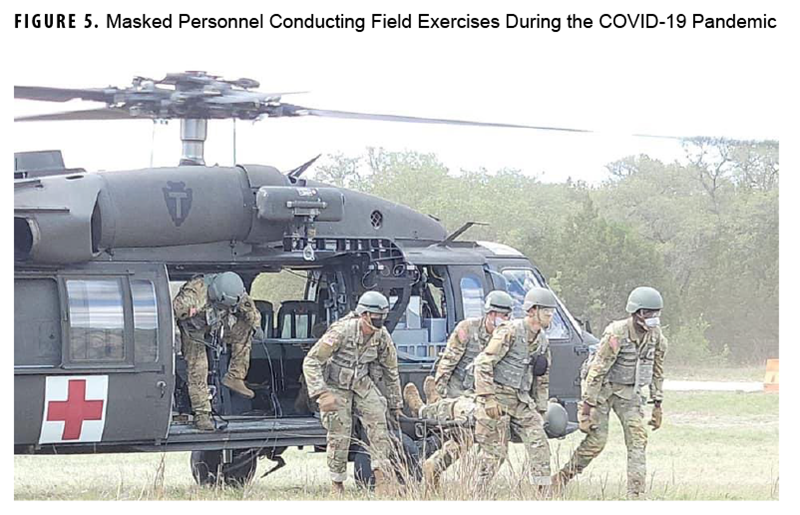
Early in 2020 the Army faced, in both viral virulence and unknown effects, an unprecedented situation—for both the short- and long-terms. The COVID-19 virus was most lethal among the elderly, not the military-age population, but large numbers of people were immuno-compromised or had other identified COVID risk factors. Protecting a far more varied population added complexities to anticipated responses by the public. The U.S. Armed Forces lost only 14 personnel, of a total force of around 2.2 million, from COVID-19 in 2020.28 By contrast, 1 county in Texas, Bexar County, which includes San Antonio, suffered around 5,000 deaths from a population of 2 million.29
The military restricted recruiting, training, and travel in different ways at different times; in addition, service members were issued personal protective equipment; and DOD modified facilities to reduce spread of the virus. With few operational requirements, risk was comparatively limited and command focus could be placed on protecting the force. U.S. Forces Korea had the opportunity to institute the dramatically-named Operation Kill The Virus because USFK had only routine operational requirements.30 Notably, one aircraft carrier group had to dock in response to an outbreak aboard ship.31
No Uniform Answers
Throughout the past century, the U.S. Army faced wartime pandemics that presented both known and unknown threats. The pandemics of 1918 and 1968 had similarities, most significantly large forces at war overseas, as well as differences, most notably that, by 1968, the influenza virus had been identified and a reliable vaccine developed. The 2009 pandemic occurred during substantial overseas military operations but involved a well-understood virus for which there were effective anti-virals. The latest pandemic was markedly different, and the next pandemic will be different yet again.
Medical advice has always played a role in the Army’s pandemic responses, but there was a time when the Army, as well as national, leadership felt it appropriate to accept the certainty of more sickness and death to reduce risk of battlefield defeat. At various times doctors have advised no immediate action against disease outbreaks. The COVID pandemic occurred in a new operational, as well as societal, paradigm focused on protecting the force, along with military families and the civilian workforce.
History does not provide a ready solution to successfully combat threats posed by pandemics, instead demonstrating military ad hoc pragmatism. None of these examples may be appropriate in the future. One thing is certain: There will be future pandemics, and public health leaders will again have to communicate threats and risks to Army leaders who will, in turn, have to weigh their missions with medical risks and practicable mitigation methods. At some point in the future, the Army may have to explain to its officers, soldiers, and the American public why it is unable to prioritize force health protection, instead putting “mission first” before “people always.”
Author Affiliation
U.S. Army Medical Department Center of History and Heritage, U.S. Army Medical Center of Excellence
Disclaimer
The views expressed in this article are those of the author and do not necessarily reflect the official policy of the Department of Defense nor the U.S. Government.
References
- March P. The Nation at War. Doubleday; 1932:359-360.
- Byerly C. Fever of War. New York University Press; 2005:104-107.
- Barry J. The Great Influenza: The Epic Story of the Deadliest Plague in History. Penguin; 2004:83-84,148,191-192,301-308.
- Gillett M. The Army Medical Department 1917-1941. U.S. Army Center of Military History; 2009:166-168,186,212.
- Crow K. Fort Leavenworth and the 1918/19 Flu Pandemic. Manuscript.
- Kansas City, Missouri. Influenza Encyclopedia–The American Influenza Epidemic of 1918-1919: A Digital Encyclopedia. University of Michigan Center for the History of Medicine and Michigan Publishing, University of Michigan Library. Accessed Jan. 8, 2021. http://www.influenzaarchive.org/cities/city-kansascity.html#
- Meiklejohn G. History of the Commission on Influenza. In: Woodward T, The Armed Forces Epidemiological Board: History of the Commissions. Office of The Surgeon General; 1994:164.
- Kundin WD, Wiebenga NH, Rosenberg EB. Hong Kong influenza: serologic, immunochemical, and epidemiologic studies of various aspects of the 1968 outbreak in Americans in Asia. Chinese J Microbiology. 1970;3(6):6-14.
- Dehner G. (2021). Interview by Dan Snow [video recording]. Hong Kong Flu [internet series/podcast]. In Dan Snow's History Hit. Accessed Oct. 20, 2021. https://play.acast.com/s/dansnowshistoryhit/hongkongflu
- Hannoun C, Craddock S. Hong Kong Flu (1968) revisited 40 years later. In: Giles-Vernick T, Craddock S, eds., Influenza and Public Health: Learning from Past Pandemics. Earthscan; 2010:180-190.
- Blakely D. Mass Mediated Disease: A Case Study Analysis of Three Flu Pandemics and Public Health Policy. Lexington Books; 2006:129-130,134.
- U.S. Deptartment of the Army. Debriefing Report (RCS-CSFOR-74), Republic of Vietnam, BG Spurgeon Neel, 1 August 1968–1 February 1969, 1 February 1969. Accessed Dec. 6, 2023. https://apps.dtic.mil/sti/tr/pdf/AD0513162.pdf
- Fort Sam Houston Talon. Archive, 1968-1969. Located at: Fort Sam Houston Museum.
- Flu shot program stressed by 2nd armd. div. medics. The Armored Sentinel, Fort Hood, Texas. Oct. 11, 1968:9. Accessed Oct. 20, 2021. https://texashistory.unt.edu/ark:/67531/metapth254999/m1/9/zoom/?q=date:1968-1969influenza&resolution=6&lat=3515.5&lon=2190.5
- Old Ironsides personnel get Asian flu shots. The Armored Sentinel, Fort Hood, Texas. Oct. 25, 1968:8. Accessed Oct. 20, 2021. https://texashistory.unt.edu/ark:/67531/metapth255000/m1/8/zoom/?q=date:1968-1969influenza&resolution=4&lat=4488.000000000001&lon=3789.9999999999995
- Hong Kong flu not in evidence at FUSA posts. The Armored Sentinel, Fort Hood, Texas. Dec. 20, 1968:7. Accessed Oct. 20, 2021. https://texashistory.unt.edu/ark:/67531/metapth255007/m1/7/zoom/?q=date:1968-1969influenza&resolution=3&lat=6165.18046534377&lon=2858.4838700426426
- News script. WBAP-TV, Fort Worth, TX. Dec. 30, 1969. Accessed Oct. 20, 2021. https://texashistory.unt.edu/ark:/67531/metadc1215834/?q=%20date%3A1968-1969+influenza
- News script. WBAP-TV, Fort Worth, TX. Dec. 31, 1969. Accessed Oct. 20, 2021. https://texashistory.unt.edu/ark:/67531/metadc1215088/?q=%20date%3A1968-1969+influenza
- News script. WBAP-TV, Fort Worth, TX. Dec. 17, 1968. Accessed Oct. 20, 2021. https://texashistory.unt.edu/ark:/67531/metadc1038188/m1/3/?q=20date:1968-1969%20influenza
- Meiklejohn G, Eickhoff T. Prevention of Influenza and Other Respiratory Diseases: Annual Progress Report. Armed Forces Epidemiological Board; 1969.
- Neel S. Medical Support of the U.S. Army in Vietnam 1965-1970. U.S. Army Center of Military History; 1973:111.
- Office of the Surgeon General. Health of the Army. 1969;23(1).
- Office of the Surgeon General. Health of the Army. 1969;24(1).
- Office of the Surgeon General. Health of the Army. 1970;25(1).
- Smith T, Olson LC, Kandel GE, et al. Hong Kong influenza in U.S. military airmen in Thailand. Am J Trop Med Hygiene. 1970;19(5):866-871.
- Jeffrey DD, Choen M, Brooks A, et al. Impact of the 2009 influenza (H1N1) pandemic on the United States military health care system. Mil Med. 2013;178(6):653-658. doi:10.7205/MILMED-D-12-00345
- Hayward RT. An Examination of the Response of U.S. Army Reserves (COMPO 3) Medical Units During the COVID-19 Pandemic [Master's thesis]. U.S. Army Command and General Staff College; 2021:91.
- Dutton L, et al. Combating an invisible enemy: the American military response to global pandemics. Mil Med Res. 2021;8(8):11-20.
- Reports & Statistics. COVID-19 San Antonio. Accessed Nov. 15, 2021. https://covid19.sanantonio.gov/Reports-Statistics/Surveillance
- Kim S, et al. Responding to COVID-19 among U.S. military units in South Korea: the U.S. Forces Korea’s Operation Kill the Virus. Mil Med. Feb. 2, 2021. Accessed Oct. 20, 2021. https://doi.org/10.1093/milmed/usab013
- Legendre BW, Boltz J, Riegodedios AJ, et al. Seroepidemiologic investigation of a COVID-19 outbreak aboard a U.S. Navy ship. MSMR. 2022;29(12):2-10.